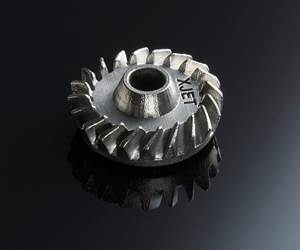AddUp AISI 420 Steel Enables More Complex, Efficient Injection Tooling Molds
This stainless steel is commonly used to manufacture molds for plastic injection molding, as it has both high mechanical strength and good corrosion resistance.
AddUp’s shaping AISI 420 steel is commonly used in the field of plastic injection and can now be used for additive manufacturing (AM). The company says AISI 420 steel can enable tooling manufacturers to develop new, more complex and more efficient molds. The material is now available for all FormUp 350 New Generation Powder Bed Fusion (PBF) machines.
AddUp, a joint venture created by Michelin and Fives, says it is one of the first players in the metal 3D printing sector to offer a recipe for implementing AISI 420 steel. Also referred to in the German standard as 1.4021 or 1.2083, this stainless steel is commonly used to manufacture molds for plastic injection molding, as it has both high mechanical strength and good corrosion resistance.
This development for AISI 420 adds to its broad portfolio of materials for the tooling sector, including 316L stainless steel and Maraging 300 (M300) steel. AddUp’s experience with these materials has enabled the production of millions of parts for tire molds.
The company says the shaping AISI 420 steel is compatible with existing postprocessing solutions. By proposing a recipe for AISI 420 steel, a grade that has proven itself in the production of plastic injection molds, AddUp is betting on rapid adoption by industrialists in the tooling field.
“Unlike alloys specially designed for additive manufacturing, which require users to invest in developing suitable postprocessing, we offer here a widely used grade,” says Frédéric Sar, AddUp materials manager. “With AISI 420, the post-printing operations are identical to those of parts produced by forging. Existing solutions in heat treatments, surface treatments, machining settings and insert grades are directly applicable to printed parts.”
Thus, manufacturers have a wide range of treatments at their disposal, enabling them to target specific properties for each application. For example, the “quenching/tempering”-type heat treatments already available for raw 420 steel enable printed parts to display tensile strength characteristics in the range of 1350 to 1980 MPa, with elongation at break values of 2 to 10%, depending on the tempering temperature. And, standard surface treatments (such as nitriding) can significantly increase the surface hardness of parts after machining. Finally, the AISI 420 alloy does not contain cobalt or nickel, making it compatible with the requirements of the REACH directive.
The material is also availabe for use at the WBA Tooling Academy. AddUp installed a FormUp 350 New Generation PBF machine at the WBA (Aachener Werkzeubau Akademie GmbH), a technical center in Germany for tooling. The machine is equipped with AISI 420 stainless steel powder and the newly developed recipe, capable of printing parts with meager porosity rates (less than 0.05%, which guarantees durability for molds subjected to high stress).
With this new industrial production tool, German tool manufacturers can submit their application cases and will be supported at all stages of their projects, from assistance in designing optimized molds to printing parts and studying the feasibility of mass production.
- Learn about AddUp’S FormUp 350 Evolution which is designed to produce large metal parts with a high level of complexity and precision — an ability which is in high demand in the aeronautics, space, defense and energy sectors.
- Check out this article about AddUp’s collaboration with Zeda to support Zeda’s growth in the aerospace and medical sectors.
- Read this article about AddUp’s partnership with Interspectral for melt pool monitoring system which reduces quality inspection costs and improves efficiency by tracking in real-time both power and emissivity drifts.
Related Content
How Siemens Energy Applies Additive Manufacturing for Power Generation and More
At an applications center in Orlando, Florida, a small team of AM specialists is spanning industries by 3D printing parts to support both Siemens Energy power generation systems and external customers.
Read MoreAM 101: What Is Hot Isostatic Pressing (HIP)? (Includes Video)
Hot isostatic pressing has long been used for metal castings, but is now being applied as a valuable method for closing porosity in metal 3D printed parts.
Read MoreHow to Build 10,000+ Shot Molds in Hours
Rapid tooling isn’t so rapid when it takes days to 3D print a metal mold, and then you still must machine it to reach the necessary tolerances. With Nexa3D’s polymer process you can print a mold in hours that is prototype or production ready and can last for more than 10,000 shots.
Read MoreAM 101: NanoParticle Jetting (NPJ)
The proprietary process from XJet builds ceramic and metal parts using nanoparticle suspensions. Learn how NPJ works in this introductory article, part of our AM 101 series.
Read MoreRead Next
3D Printing Brings Sustainability, Accessibility to Glass Manufacturing
Australian startup Maple Glass Printing has developed a process for extruding glass into artwork, lab implements and architectural elements. Along the way, the company has also found more efficient ways of recycling this material.
Read More4 Ways the Education and Training Challenge Is Different for Additive Manufacturing
The advance of additive manufacturing means we need more professionals educated in AM technology.
Read MoreAt General Atomics, Do Unmanned Aerial Systems Reveal the Future of Aircraft Manufacturing?
The maker of the Predator and SkyGuardian remote aircraft can implement additive manufacturing more rapidly and widely than the makers of other types of planes. The role of 3D printing in current and future UAS components hints at how far AM can go to save cost and time in aircraft production and design.
Read More








.png;maxWidth=300;quality=90)















